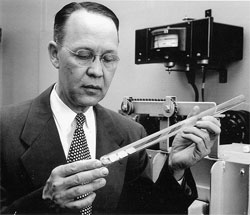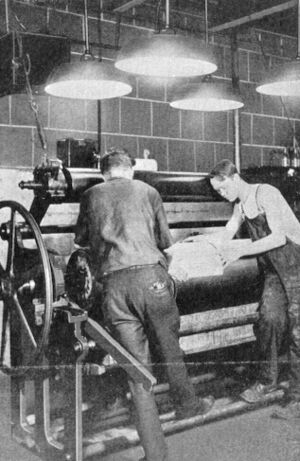Calvin Souther Fuller facts for kids
Quick facts for kids
Calvin Souther Fuller
|
|
|---|---|
 |
|
| Born | May 25, 1902 |
| Died | October 28, 1994 (aged 92) |
| Nationality | American |
| Citizenship | United States |
| Alma mater | University of Chicago, PhD |
| Known for | Invention of the solar cell |
| Awards | Elected to US National Inventors Hall of Fame, May 2, 2008, for invention of the "Silicon Solar Cell" along with Daryl Chapin and Gerald Pearson.
Elected to New Jersey Inventors Hall of Fame, June 22, 2006, for Development of the Semiconductor Photovoltaic Solar Cell. Winner of Alfred Krupp Award, Heidelberg University, Germany. Received the John Price Wetherill Medal in 1963. |
| Scientific career | |
| Fields | Physical Chemistry |
| Institutions | AT&T Bell Laboratories |
Calvin Souther Fuller (born May 25, 1902 – died October 28, 1994) was an American physical chemist. He worked at AT&T Bell Laboratories for 37 years, from 1930 to 1967. Fuller was part of a team that solved tough scientific problems. He helped create synthetic rubber during World War II. He also helped invent the first effective solar cells. These cells could turn sunlight into electricity. He also studied polymers, which are materials made of many small units linked together.
Early Life and Work
Calvin Fuller was born in Chicago on May 25, 1902. He studied chemistry at the University of Chicago. He earned his bachelor's degree in 1926 and his Ph.D. in 1929.
Before joining Bell Labs, he worked for the General Chemical Company and the Chicago Tribune. In 1930, he moved to Murray Hill, New Jersey. There, he started his job as a physical chemist at Bell Labs. He married Willimine Works in 1932.
During World War II, the supply of natural rubber was cut off. Calvin Fuller joined a team to develop synthetic rubber. This was a huge effort involving many scientists and labs. Fuller and his colleague W.O. Baker helped improve the process. By 1945, a lot of synthetic rubber was being made.
Inventing the Solar Cell
Calvin Fuller worked with fellow Bell Telephone scientists Daryl Chapin and Gerald Pearson. They found a way to use silicon to capture the Sun's energy. They added a material called boron to silicon. This created the first practical way to turn sunlight into electricity.
Their invention, called the solar battery, was a big step forward. It made it 600% better at turning sunlight into power. First, Fuller made sure the silicon was very pure. Then, he successfully added boron to it. The inventors used small strips of silicon. These strips could capture sunlight and create free electrons. Bell Laboratories, which paid for the research, announced the new solar battery.
Calvin Fuller's oldest son, Robert W. Fuller, shared a story about the invention. In 1954, his father came home with a small, quarter-like object with wires. This was a silicon solar cell. His father shined a flashlight on it, and a tiny electric windmill on the table started turning. It was amazing to see the flashlight power the windmill. This small device was the world's first silicon solar battery. Today, we know it as the silicon solar cell.
The first public test of the Bell Solar Battery happened in 1955. It was used in a telephone system in Americus, Georgia. By 1958, the US Department of Defense saw its value. They used solar cells to power vehicles and satellites in space.
Research on Polymers
Fuller also did important research on polymers at Bell Labs. Polymers are large molecules made of repeating units. He studied how the connections between these units affected a material's stretchiness and tensile strength (how much it can resist breaking).
Bell Labs was looking for a perfect insulator. An insulator stops electricity from flowing. They needed one for coaxial cables, which carry high-frequency signals. Fuller found that polyethylene was a good choice. It did not have "polar groups" that could interfere with signals. He helped create some of the first cables using this common insulator.
Personal Life
Calvin Fuller was married to Willmine Fuller. They had three sons: Robert W. Fuller, Stephen, and John. They also had eight grandchildren. When he turned 65, Fuller retired from Bell Labs. He and Willmine moved to Vero Beach, Florida. In retirement, he bought an Airstream RV. They traveled all over the United States.
Calvin Fuller passed away in Vero Beach, Florida, in 1994. He was 92 years old. His grandson, Ben Fuller, shared stories about his hobbies. Calvin loved growing large red tomatoes in his New Jersey garden. He also enjoyed photography, taking pictures of his family and landscapes. He was also very good at fixing things around the house.


